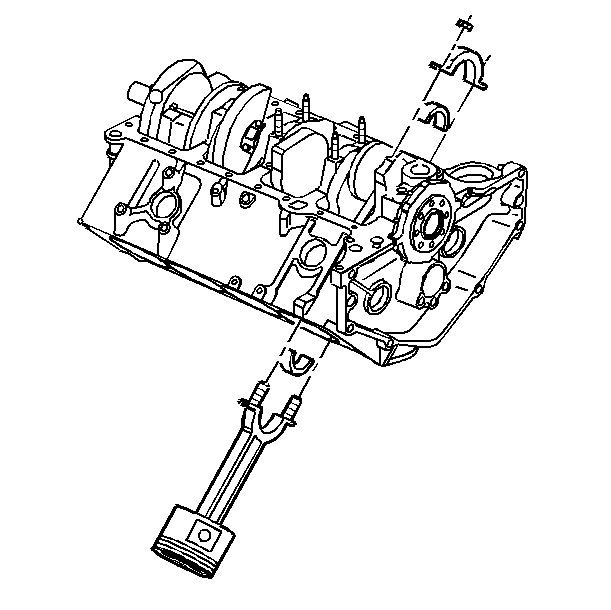Removal Procedure
The connecting rod bearings are the precision insert type and cannot
be adjusted with shims. Do not file the connecting rods or the rod caps. If
the clearances are excessive, install a new bearing. Service bearings are
available in the following sizes:
| • | Standard size and 0.025 mm (0.001 in) and 0.051 mm
(0.002 in) undersize for use with new and used standard size crankshafts |
| • | 0.25 mm (0.010 in) and 0.51 mm (0.020 in)
undersize for use with reconditioned crankshafts |
When you remove a connecting rod cap, you may find a 0.25 mm
(0.010 in) undersize bearing. These bearings are used in manufacturing
for selective fitting.
- Remove the oil pan. Refer to
Oil Pan Replacement
.
- Remove the oil pump. Refer to Oil Pump Replacement
.
Important: Place matchmarks or numbers on the connecting rods and the connecting
rod caps. Assemble the connecting rod caps to the matching connecting rods.

- Remove the connecting rod nuts.
- Remove the connecting rod cap and bearings.
| • | Keep the bearings with their original connecting rod and connecting
rod cap. |
| • | Wipe the oil from the bearings and the crankpins. |
- Inspect the bearings for excessive wear or damage.
- Use a micrometer in order to measure the crankpin for out-of-round
and taper. Refer to Engine Mechanical Specifications (LT1)
.
| • | If the measurements are not within specifications, replace or
recondition the crankshaft. |
| • | If you install new bearings, determine the new bearing size from
the maximum crankpin diameter. |
- Use gauging plastic in order to measure the bearing clearances.
| 7.1. | Use a piece of gauging plastic full width of the bearing (parallel
to the crankshaft) onto the crankpin. Position the gauging plastic in the
middle of the bearing. This is where the bearing is thickest. |
| 7.2. | Install the connecting rod cap with the bearing onto the connecting
rod. |
| 7.3. | Install the connecting rod nuts. |
Tighten
Tighten the connecting rod nuts evenly to 27 N·m (20 lb ft)
plus an additional 55 degrees.
Notice: Use the correct fastener in the correct location. Replacement fasteners
must be the correct part number for that application. Fasteners requiring
replacement or fasteners requiring the use of thread locking compound or sealant
are identified in the service procedure. Do not use paints, lubricants, or
corrosion inhibitors on fasteners or fastener joint surfaces unless specified.
These coatings affect fastener torque and joint clamping force and may damage
the fastener. Use the correct tightening sequence and specifications when
installing fasteners in order to avoid damage to parts and systems.
| 7.4. | Remove the connecting rod nuts and the connecting rod cap. The
gauging plastic will adhere to either the connecting rod cap or to the crankshaft
journal. Leave the gauging plastic in place in order to measure it. |
| 7.5. | Use the scale that is provided with the gauging plastic in order
to measure the gauging plastic at its widest point. Refer to Engine Mechanical Specifications (LT1)
. |
| • | If the clearance is greater than specifications allow, select
an undersize bearing and re-measure the clearance. |
| • | Re-grind the crankpin if you cannot bring the clearance to specifications.
Replace the crankshaft if the crankpin is already at the maximum undersize. |
| 7.6. | Remove the gauging plastic. |
Installation Procedure

- Coat the inside surface of the bearings with engine oil.
- Install the connecting rod cap and bearings.
- Install the connecting rod nuts.
Tighten
Tighten the connecting rod nuts evenly to 27 N·m (20 lb ft)
plus and additional 55 degrees.
Notice: Use the correct fastener in the correct location. Replacement fasteners
must be the correct part number for that application. Fasteners requiring
replacement or fasteners requiring the use of thread locking compound or sealant
are identified in the service procedure. Do not use paints, lubricants, or
corrosion inhibitors on fasteners or fastener joint surfaces unless specified.
These coatings affect fastener torque and joint clamping force and may damage
the fastener. Use the correct tightening sequence and specifications when
installing fasteners in order to avoid damage to parts and systems.
- Measure the connecting rod side clearance.
| • | When you have installed all of the connecting rod bearings, lightly
tap each connecting rod parallel to the crankpin in order to ensure that they
have clearance. |
| • | Use a feeler gauge or a dial indicator in order to measure the
side clearance between the connecting rod caps. |
| • | The rod side clearance should be 0.16-0.35 mm (0.006-0.014 in). |
- Install the oil pump. Refer to Oil Pump Replacement
.
- Install the oil pan. Refer to
Oil Pan Replacement
.


